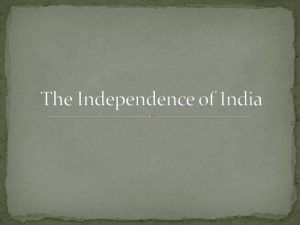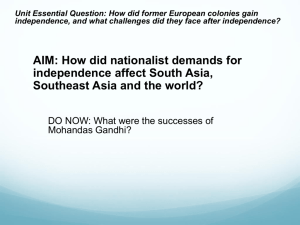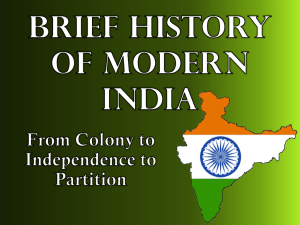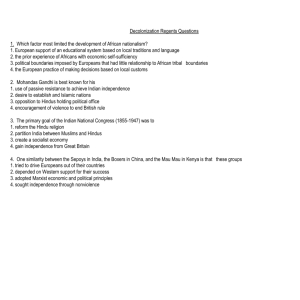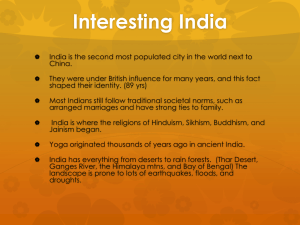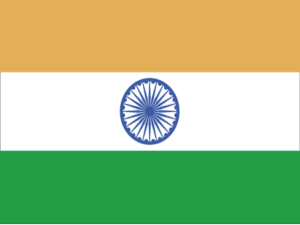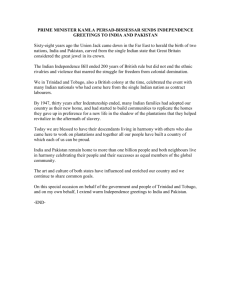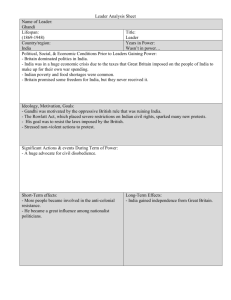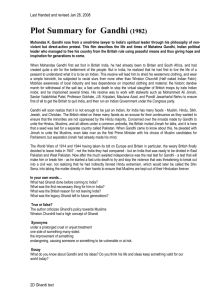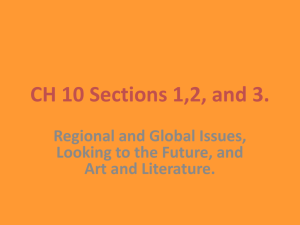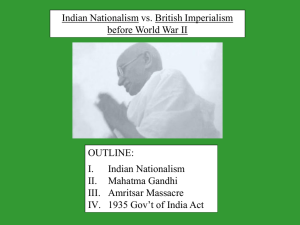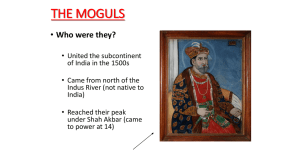Brief History of Modern India
advertisement
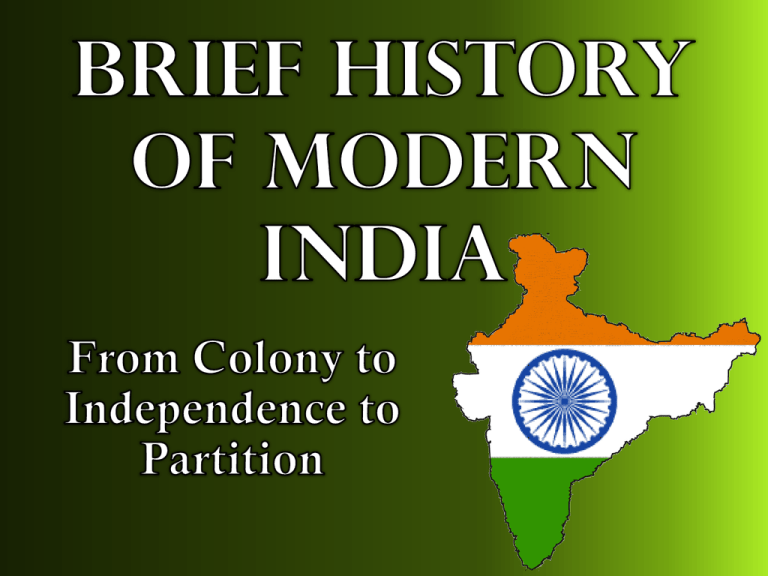
• Located on the subcontinent of India – A large landmass that juts out of Asia – Situated just south of the Himalayan & Hindu Kush Mountains – Located in between the Indus River and the Ganges River – Climate dominated by monsoons • Strong, often violent winds that change direction with the seasons India’s Monsoons • India’s winters are hot and dry: winds blow from the northeast with very little moisture India’s Monsoons • India’s summer sees winds blowing from the southwest • The summer is dominated by torrential rainstorms often causing violent landslides; however are welcomed by farmers and to provide electricity • These factors kept the culture of the Indus River very isolated from the rest of Asia • The Indus River Valley grew into a thriving civilization by 2500 BCE. • The Dravidians lived in the south and were eventually eclipsed by the Aryans migrating from the northeast. • India initially was consolidated under the Gupta Dynasty – Other powerful dynasties included the Magadha, Kosla, Kuru and Gandhara Dynasties Dravidians Aryans • In the 10th century a Muslim rulers from Turkey & Afghanistan began invading and by the 12th century, had established the Delhi Sultanate – 5 Dynasties that ruled India as a kingdom • The Delhi Sultanate was absorbed by the Mughal Empire which ruled the land for over 300 years (1526–1857). – Led to an "Indo-Muslim" fusion of cultures • Europeans Arrive Europeans began arriving in India in 1500’s – they were hoping to make money from the lucrative spice trade Vasco da Gama of Portugal Seven Years’ War: British defeat French (Here we know it as the French & Indian War!) • A company that was founded by way of a charter from the monarch of Britain for pursuing trade with the East Indies, but ended up trading mostly with the Indian subcontinent, present-day Pakistan, and parts of Iran Tea Silk Cotton • During the 1700’s and 1800’s the East India Company slowly took control of India • As the Mughal Empire grew weak, the East India Company grew in economic and political strength and began to build its own military force • The military force mainly consisted of sepoys , Indian soldiers, led by British commanders • The British wanted many of the raw materials India produced – cotton, indigo, jute (burlap), spices, sugar, and tea • These material were shipped to Britain for use in British factories – finished products were then shipped around the world to British colonies • Advantages of the British invasion – railroads, education, hospitals, common language, • Disadvantages– low wages, few rights, no say in government • The strength of British control angered many of the Indians • 1857 the sepoy troops rebelled • The British suppressed the rebellion and abolished the British East India Company • India officially became a British colony In 1877 • Queen Victoria took the title Empress of India • Indians never really accepted British rule • In the late 1800’s Indian nationalists created the Indian National Congress • Rather than demand independence, the Congress asked for equal treatment and representation in government – The British refused – National Congress’s goals slowly changed from seeking reform to demanding independence • Britain promises India self-rule if they help fight in the war – 1.25 million Indians served with British military • When war ends, Britain made a few reforms but refused to grant India selfgovernment • High casualty rates, increasing inflation compounded by heavy taxation, the deadly 1918 flu pandemic, and the disruption of trade during the war escalated human suffering in India • Result: Revival of Independence Movement • Amritsar was a city in Punjab (Indian state) where protests and gatherings were making the British increasingly nervous • 1919, British general (Reginald Dyer) banned public meetings in the city of Amritsar • Many people ignored the order and gathered in a public garden called Jallianwala Bagh for the Sikh Festival "Baisakhi fair” & to protest British rule • Dyer arrived with British troops • Giving no word of warning, ordered 50 soldiers to fire into the gathering • In 10 to 15 minutes 1,650 rounds of ammunition were unloaded into the screaming, terrified crowd • Dyer then marched away, leaving 379 dead and over 1,500 wounded • Dyer—without warning the crowd to disperse—blocked the main exits. He explained later that this act "was not to disperse the meeting but to punish the Indians for disobedience.” Dyer ordered his troops to begin shooting toward the densest sections of the crowd. Firing continued for approximately ten minutes. Cease-fire was ordered only when ammunition supplies were almost exhausted, after approximately 1,650 rounds were spent Entrance to the public garden, Jallianwala Bagh Passageway to the public garden, Jallianwala Bagh Memorial monument to those lost in the massacre Bullet Marks still left from April 13, 1919 Martyr's Well Martyr's Well • Please read the biography of Mahatmas Gandhi for tomorrow’s class. • The Amritsar Massacre stirred nationalist feelings across India and had a profound effect on one of the movement's leaders, Mohandas Gandhi. • After the Amritsar Massacre he became convinced that India should accept nothing less than full independence. • To achieve this end, Gandhi began organizing his first campaign of mass civil disobedience against Britain's oppressive rule. • Gandhi emerges as spiritual leader for Indian Independence • A. Civil Disobedience - refusing to obey unjust laws and purposely breaking them • B. Passive Resistance - Non-violent protests using two major aspects: – Satyagraha = “soul force”, meaning opponents must be weaned from error by patience and compassion – Ahimsa = “Love for all”…even your enemies 1. 2. 3. 4. 5. 6. 7. Wealth without work Pleasure without conscience Knowledge without character Commerce without morality Science without humanity Worship without sacrifice Politics without principle • Boycotts British goods – especially textiles. • He encouraged homespun clothing and wore a dhoti, simple white garment traditionally worn by villagers. • Goes on hunger strikes in prison and calls for the stoppage of any violent protests. • British law claimed that the British had sole right to produce and sell salt in India • Gandhi wrote to Viceroy stating his intent to break the law • With 78 followers he marched 240 miles to the sea. • By the time he reached the sea, thousands of people had joined the march • Gandhi and others harvested salt from the sea and were arrested • Reporters around the world reported the incident. • The event embarrassed the British government who prided themselves on their democratic traditions. 1. The salt tax was a deeply symbolic choice, since salt was used by nearly everyone in India, to replace the salt lost by sweating in India's tropical climate 2. An item of daily use could resonate more with all classes of citizens 3. He also reasoned that it would build unity between Hindus and Muslims by fighting a wrong that touched them equally • After WWII – Britain realized it could no longer keep control of South Asia • This developed into a new set of problems – the mistrust and hostility between India’s Muslim population and Hindu population • Neither group trusted the other – the Hindus greatly outnumbered the Muslims and the Muslims feared Hindu rule • In 1947, the Indian subcontinent won its independence from Great Britain, creating the world’s largest democracy with over one billion people. • However, Muslim League leader Muhammad Ali Jinnah argued that Muslims should have their own state. • In 1947 India was divided into 2 nations: – Land with a Hindu majority became India – Land with a Muslim majority became Pakistan in the west • Burma (Myanmar) and Ceylon (Sri Lanka) became independent the following year. • The border between the two states was drawn hastily, using outdated census reports and maps. • At the epicenter of the Indian-Pakistan conflict is the Jammu-Kashmir state, which, in 1947, had a predominantly Muslim population but was officially signed over to India – Three wars have been fought over this region. Arbitrary borders divided states – Punjab was divided between Pakistan & India • Due to this Hindu-Muslim split, a Great Migration occurred where Hindus in Pakistan and Muslims in India left their homes in an attempt to go where they felt accepted. – 9 million Hindus left Pakistan and 6 million Muslims left India. • Unfortunately, this led to horrendous violence and riots that killed millions of people. • Jawaharal Nehru was India’s first Prime Minister. – Introduced a Western-style, secular government based on universal suffrage, religious freedom, social equality and abolition of the caste system. – Indian economy successfully combined government-run industry with private enterprise • Relations between Pakistan and India remain unstable. – Both nations want to control the Jammu and Kasmir regions near the Pakistan-India border. • Tensions continued to increase after both India and Pakistan tested nuclear weapons in 1998. • A grouping acronym that refers to the countries of Brazil, Russia, India, and China: BRIC • All deemed to be at a similar stage of newly advanced economic development – Symbol of the shift in global economic power away from the developed G7 • France, Germany, Italy, Japan, United Kingdom, USA, & Canada • It is estimated that BRIC economies will overtake G7 economies by 2027 • They account for more than a quarter of the world's land area and more than 40% of the world's population The ten largest economies in the world in 2050, measured in GDP (billions USD), according to Goldman Sachs Categories Brazil Russia India China USA Area 5 1 7 3 4 Population 5 9 2 1 3 107 221 90 156 118 5 7 2 1 3 GDP Growth Rate 115 87 13 6 159 Human Development Index* 73 65 119 89 4 Exports 22 9 19 1 2 Imports 20 17 10 2 1 External Debt 25 22 27 18 1 Electricity Consumption 10 5 3 1 2 Mobile Phones 5 4 2 1 3 Internet Users 5 7 4 1 2 Population Growth Labor Force • From 1947-1991, India’s economy was a mix of socialism and capitalism – Relied heavily on government intervention in the economy – Relied on replacing foreign imports with domestic production – Result: shortages and inefficiency and corruption within government • 1991-present: free-market economy with a focus on international trade
